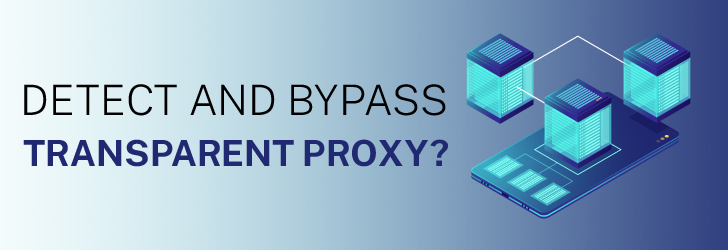
Proxies sit between an user and the web. It is used to intercept requests from a user, send web requests to the servers and forward the responses from the server to the user. It acts like a web filter or a firewall to enhance network security. Proxies also cache data to speed up the network connection.
Proxies are used to monitor traffic, increase network security, channelize bandwidth usage, block restricted content and safeguard privacy. Proxies are classified into the below types:
- Transparent proxy
- Anonymous Proxy
- High Anonymity Proxy
- Distorting Proxy
To use a proxy, you would require making certain network setting changes. This will allow connections to flow via the proxy server.
What is a transparent proxy?
A transparent proxy is also referred to as a forced proxy, inline proxy or intercepting proxy. Contrary to a regular proxy, a transparent proxy does not require any changes to the existing settings. It gets implemented without the knowledge of the user while browsing the internet.
A transparent proxy does not manipulate the request or change your IP. It performs redirection and can be used for authentication. Transparent proxy works as a caching proxy which is implemented by the ISP. It is unknown to the user since the user cannot see any difference in the way requests are being handled. All configurations are handled by the ISP.
Squid is one of the commonly used software to set up a transparent proxy. A transparent proxy is usually used to cache certain high bandwidth resources. For instance, a video will be cached to a proxy server and when a request is made to view this video, the cached copy will be presented without sending a request to the destination server. This is implemented to use bandwidth effectively and makes the response time shorter.
Organizations use transparent proxy to restrict access to specific websites. This is used to censor content. A transparent proxy can block access to the internet based on specific rules. Such proxy servers are also used to prevent DDoS attacks. It prevents such redundant requests from flooding and bringing down the actual destination server.
One of the downsides of having transparent proxy is that user control is taken away by a transparent proxy without the user being aware of it. This is a privacy concern. Secondly, a transparent proxy is not robust and can be susceptible to man in the middle attack. The network traffic can be rerouted to a different proxy.
Transparent proxy depends on the browser behavior and will fail in certain legacy browsers.
Detect and Bypass a Transparent Proxy:
The main issue with transparent proxy is that all your traffic can be monitored. An ISP can completely track your network traces. In case you do not wish to be monitored, the first step is to detect if you are using a transparent proxy.
To detect if you are using a transparent proxy, you can use our proxy checker tool. The tool highlights if you're using a transparent proxy.
Another common method is by typing an invalid URL in the Chrome address bar. A typical error message from Chrome when a website is not found will be different from the error message displayed when you are connected using a transparent proxy.
If you are browsing an HTTPS website, you can view the SSL certificate information by clicking on the lock symbol over the browser. This certificate will appear to be different when it's from an ISP.
Yet another method is by trying to use a Smart DNS proxy such as Unblock-us or Unlocator to bypass geographical restrictions to access websites such as Netflix. In case you are connected using a transparent proxy then you would not be able to successfully access these websites since the transparent proxy interrupts the Smart DNS logic.
Apart from this, there are several more complex and sophisticated tools to detect a transparent proxy. Command such as Nmap is also used to detect transparent proxy.
An alternate way of protecting online privacy would be to use a VPN instead of a proxy. VPN makes it impossible for the ISP to detect your traffic and redirect to a specific proxy server. The complete traffic is encrypted and hence makes it difficult for the transparent proxy to override the traffic. As a result, the traffic reaches as it is to the destination server.
Certain routers can also implement VPN over IPsec or OpenVPN gateways. This adds a layer of encapsulation, thereby making the traffic hard to be deciphered over a network.
Share this post
Leave a comment
All comments are moderated. Spammy and bot submitted comments are deleted. Please submit the comments that are helpful to others, and we'll approve your comments. A comment that includes outbound link will only be approved if the content is relevant to the topic, and has some value to our readers.

Comments (0)
No comment